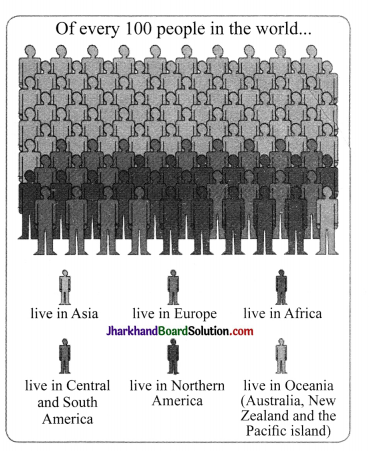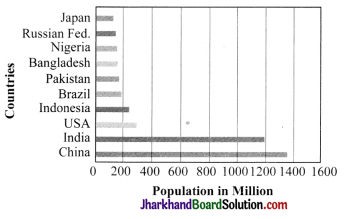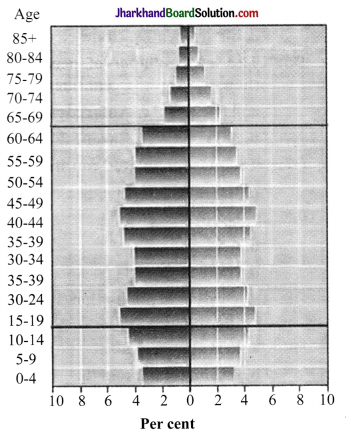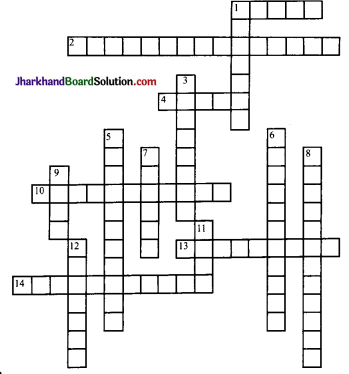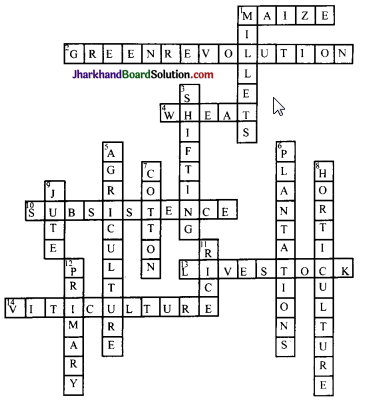JAC Board Class 8th Social Science Solutions Civics Chapter 10 Law and Social Justice
JAC Class 8th Civics Law and Social Justice InText Questions and Answers
Page 121
Question 1.
Why do we need a law on minimum wages?
Answer:
We need a law on minimum wages because the employers usually take advantage of the worker’s poverty and pay them low wages and make them work for extra hours. If there is a law then the workers may get a fair wage for their work.
Question 2.
Find out:
(a) What is the minimum wage for a construction worker in your state?
(b) Do you think the minimum wage for a construction worker is adequate, low or high?
(c) Who sets the minimum wages?
Answer:
Students need to do it on their own.
Hint:
(a) The minimum wage rate for unskilled worker in Delhi is ?14,468 per month.
(b) Not to low but not too high as well.
(c) The Ministry of Labour sets the minimum wages.
![]()
Page 127
Question 3.
Why do you think enforcement of safety laws is important in any factory?
Answer:
Enforcement of safety laws is important in any factory is important because serious disaster may happen if this law is not present or enforced. Many people work at high risk since they don’t have any other choice, they have to earn their livelihood. It is important in any factory for the security of the workers and people residing near the factory.
Question 4.
Can you point to a few other situations where laws (or rules) exist but people do not follow them because of poor enforcement? (For example, over-speeding by motorists, not wearing helmet/seat belt and use of mobile phone while driving). What are the problems in enforcement? Can you suggest some ways in which enforcement can be improved?
Answer:
Few other situations where laws (or rules) exist but people do not follow them because of poor enforcement are:
- Giving bribe to make their own work in illegal way.
- Employing children under 14 years of age in roadside dhabas or as domestic help.
- Boarding in a running bus.
- Giving and taking dowry at the time of marriage.
The problems in enforcement are as follows:
- Untrained staff
- Irresponsible citizen
Some ways in which enforcement can be improved are as follows:
- Deployment of trained and adequate staff for the enforcement of the law.
- Strict punishments for those who are not following the law.
Poge 128
Question 5.
A ‘clean environment is a public facility.’ Can you explain this statement?
Answer:
Clean environment is a public facility because it is a right for every citizen, to keep the environment neat and clean. So that the person himself and the surrounding people can take advantage and it will be safe for everyone’s welfare.
Question 6.
Why do we need new laws?
Answer:
For the welfare of people such as to check pollution, banning the use of plastic bags, clean river, etc., we need new laws.
Question 7.
Why are companies and contractors able to violate environmental laws?
Answer:
Companies and contractors are able to violate environmental laws because these laws are not strictly administered by the government.
Page 129
Question 8.
Do you think everyone got justice in the case cited above (See NCERT page 129)?
Answer:
No, everyone didn’t get justice in the case cited above.
![]()
Question 9.
Can you think of other ways in which the environment can be protected? Discuss in class.
Answer:
The other ways in which the environment can be protected are:
- Afforestation
- Banning the use of plastic bags
- Disposal of sewage properly
- Minimum use of private vehicle.
JAC Class 8th Civics Law and Social Justice Textbook Questions and Answers
Question 1.
Talk to two workers (For example, construction workers, farm workers, factory workers, workers at any shop) to find out if they are receiving the minimum wages laid down by law.
Answer:
Farm workers : These workers are receiving below the minimum wages.
Construction workers: These workers are also getting less wages.
Question 2.
What are the advantages to foreign companies in setting up production in India?
Answer:
The advantages to foreign companies in setting up production in India are as follows:
- Availability of very cheap labour.
- Longer hours of work at low wages.
- Minimum additional expenses such as for housing facilities for workers.
- Cost cutting by including lower working conditions that consist of lower safety measures.
- Foreign companies can save costs and earn higher profits in India in this way.
Question 3.
Do you think the victims of the Bhopal gas tragedy got justice? Discuss.
Answer:
No, the victims of the Bhopal gas tragedy didn’t get a complete justice. This tragedy was caused due to negligence of safety measures by the factory management. The Indian government represented the people to legally claim compensation for the affected people and demanded 3 billion dollar as a compensation but the company paid only 470 million dollars. Even today, after 36 years of disaster, people are still seeking justice. Financial aid was sufficient for the victim’s but many of them are still fighting for safe drinking water, healthcare facilities and jobs.
Question 4.
law enforcement? Who is responsible for enforcement? Why is enforcement so important?
Answer:
The implementation and execution of law is known as law enforcement. The government is responsible for the laws to be enforced so that the citizens can benefit from the same. The government is responsible for the enforcement of laws. For protecting the rights of the citizens, enforcement is important.
Enforcement is important when the law seeks to protect the weaker section from the stronger section. It is also necessary to control the activities of individuals or private companies so as to ensure a safe working environment and complete social justice.
Question 5.
How can laws ensure that markets work in a manner that is fair? Give two examples to support your answer.
Answer:
Laws can ensure that markets work in a manner that is fair in the following ways:
- Workers are not exploited and the government should keep a check on the worksites and punish those who violates the law.
- The government should also keep a check on the market price of the essential commodities.
Two examples are:
- Right against exploitation
- Child Labour Prevention Act
Question 6.
Imagine yourself to be a worker working in a chemical factory, which has received orders from the government to move to a different site 100 kms away from the present location. Write about how your life would change? Read out your responses in the classroom.
Answer:
Student need to do it on their own. (Hint: Due to the relocation of the factory, I have to shift to a place nearby the factory. The education of the kids will get affected. Look for a new house. Even if, I shift alone then I have to bear the expenses of two places.)
![]()
Question 7.
Write a paragraph on the various roles of the government that you have read about in this unit.
Answer:
The various roles of the government that we have read in this unit are as follows:
- Enforcement of laws regarding safety at workplace.
- Fixing minimum wages for workers and revising it from time to time.
- Enforcement of laws against child labour.
- Enforcement of laws regarding safety of environment.
- Protecting the interests of consumers in the market.
Question 8.
What are the sources of environmental pollution in your area? Discuss with respect to (a) air; (b) water and (c) soil. What are the steps being taken to reduce the pollution? Can you suggest some other measures?
Answer:
The sources of environmental pollution in my area with respect to:
- Air: Factories, industries and transport emits more dangerous and unsafe gases.
- Water: Disposal of industrial waste in Yamuna river, immersion of idols, pouring garbage in river.
- Soil: There is no chance of soil pollution as cultivation land is not available.
Suggestions:
- Stop the misuse or overuse of resources.
- Strict action should be taken against the practices that cause environmental pollutions such as use of plastic bags, disposal of all type of wastes and harmful emissions from industries.
- Promoting the use of CNG as fuel in vehicles and banned old vehicles. Diesel vehicles should be prohibited
- Pollution checking norms should be followed strictly.
- Encourage recycling of used materials.
Question 9.
How was environment treated earlier? What has been the change in perception? Discuss.
Answer:
In the earlier days, the environment was treated as a ‘free entity’. There was no check on the factories and industries which caused the pollution. The government paid no attention to safeguard the environment. Very few laws were applied and executed to protect and conserve the environment. There has been a vast change in perception. Now a days, government is more alert and active towards conserving the nature.
It has implemented various laws and acts to protect the environment. New and amended laws have been imposed by the government according to which the tainted person will be accountable for the harm and destruction done to the environment and shall be liable to punishment.The recent one is Swachh Bharat Abhiyan. Several judgements have been given to uphold the right to a healthy environment as intrinsic to the fundamental right to life.
Question 10.
What do you think the famous cartoonist R.K. Laxman is trying to convey in this cartoon? How does it relate to the 2016 law that you read about on page 123?
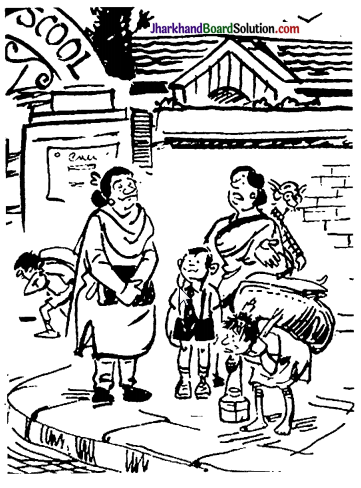
It’s really cruel burdening kids like this. I had to hire that boy to help my son!
Answer:
The famous cartoonist R.K. Laxman is trying to convey in this cartoon that how we treat children of the same age group. One child is from rich family and gets the sympathy of mother whereas, the other child is from poor family and earns for his family hence bearing the load of books, working hard to get paid.
This is injustice. The law says that it banned the employment of children below the age of 14 years in all occupations and of adolescents (14-18 years) in any occ upations and processes. It made employing these children or adolescents a cognizable offence.
![]()
Question 11.
You have read about the Bhopal gas tragedy and the on-going struggle. Students from countries across the world have come together to support this struggle for justice. From protest marches to awareness campaigns, you can read about their activities on the website www.studentsforbhopal.com.
The website also has resources such as photos, posters, documentaries, victims’ statements, etc. Use this and other sources to make a wallpaper/exhibition on the Bhopal gas tragedy for your classroom. Invite the whole school to see and talk about it.
Answer:
Students need to do it on their own.
JAC Class 8th Civics Law and Social Justice Important Questions and Answers
Multiple Choice Questions
Question 1.
Bhopal Gas Tragedy took place in the year……..
(a) December 1980
(b) December 1984
(c) January 1984
(d) March 1985
Answer:
(b) December 1984
Question 2.
……….incident brought the issue of environment to the forefront.
(a) Uttarakhand flood
(b) Bengal famine
(c) Latur earthquake
(d) Bhopal Gas tragedy
Answer:
(d) Bhopal Gas tragedy
Question 3.
The government amended the Child Prevention Act in……..banning children under 14 years of age from working in factories and as domestic help.
(a) October 2006
(b) October 2005
(c) July 2006
(d) June 2005
Answer:
(a) October 2006
![]()
Question 4.
Union Carbide was a/an……
(a) English Company
(b) American Company
(c) Indian Private Company
(d) Government owned Company
Answer:
(b) American Company
Question 5.
The owner of Union Carbide plant at present is…….. .
(a) Indian Government
(b) United Chemical
(c) Dow Chemical
(d) None of these
Answer:
(c) Dow Chemical
Question 6.
Union Carbide Bhopal plant produced
(a) fertilisers
(b) pesticides
(c) both a and b
(d) none of these
Answer:
(c) both a and b
Question 7.
Pollution caused by the Bhopal gas tragedy was…….. .
(a) water pollution
(b) air pollution
(c) no pollution
(d) both a and b
Answer:
(d) both a and b
Question 8.
The following industry/ies are hazardous:
(a) Ship-breaking industry
(b) Textile industry
(c) Sugar industry
(d) Both a and c
Answer:
(a) Ship-breaking industry
Question 9.
The gas that leaked from Union Carbide plant was……… .
(a) Ethyl alcohol
(b) Methyl Iscocyanite
(c) Methyl Isocynide
(d) Ethyl Isocyanite
Answer:
(b) Methyl Iscocyanite
Question 10.
Right to a healthy and clean environment is an essential part of the Fundamental Rights of ……
(a) Right to Freedom
(b) Right to Equality
(c) Right to Life
(d) None of these
Answer:
(c) Right to Life
Very Short Answer Type Questions
Question 1.
Economically how are the people of working class exploited?
Answer:
Economically the people of working class exploited by making them to work for lower pay and for longer hours.
Question 2.
Why do the workers willingly work in unsafe conditions?
Answer:
The workers willingly work in unsafe conditions because there is so much unemployment and they know that in return they will get wages as they are very poor.
![]()
Question 3.
What does the Right Against Exploitation state?
Answer:
The Right Against Exploitation states that no one can be forced to work for low wages or under bondage.
Question 4.
What does Article 21 of the Constitution state?
Answer:
Article 21 of the Constitution is Right to Life which is a Fundamental Right and it states that the right to the life of pollution free air and water for full enjoyment of life.
Question 5.
Who are responsible to set the minimum wages?
Answer:
The Minimum Wages Act 1948 is an Act of Parliament concerning Indian Labour Law that sets the minimum wages must be paid to skilled and unskilled labours.
Question 6.
List the three basic rights of workers.
Answer:
Three basics rights of workers are:
- Right to work
- Right to a fair wage
- Decent work conditions
Question 7.
What is the full form of CNG?
Answer:
The full form of CNG is Compressed Natural Gas.
![]()
Question 8.
Which three states have published plans to rescue and rehabilitate children who are working as domestic helps.
Answer:
Three states who have published plans to rescue and rehabilitate children who are working as domestic servants are Karnataka, Tamil Nadu and Maharashtra.
Question 9.
List three South Asian countries which play hosts for industries producing pesticides, asbestos, etc.
Answer:
Three South Asian countries which play hosts for industries producing pesticides, asbestos, etc., are India, Bangladesh and Pakistan.
Question 10:
Why were the textile mills in Ahmedabad closed down during the 1980s and 1990s?
Answer:
The textile mills in Ahmedabad closed down during the 1980s and 1990s because they were facing stiff competition from power looms during the 1980s and 1990s.
Short Answer Type Questions
Question 1.
Why do you think enforcement of safety laws is important in any factory?
Answer:
Enforcement of safety laws is important in any factory for the safety of the workers and general public. As the lawmaker and enforcer, the government is supposed to ensure that safety laws are implemented. It is also the duty of the government to ensure that the Right to Life guaranteed under Article 21 of the Constitution is not violated.
Question 2.
Why are dvanced countries relocating the toxic and hazardous industries to developing countries?
Answer:
Advanced countries are relocating the toxic and hazardous industries to developing countries to take advantage of the weaker laws in these countries and keep their own countries safe. South Asian countries – particularly India, Bangladesh and Pakistan – play hosts for industries producing pesticides, asbestos or processing zinc and lead.
Question 3.
How can the government meet the challenges where everyone can benefit from the clean environment?
Answer:
One way this can be done is to gradually move to cleaner technologies and processes in factories. The government has to encourage and support factories to do this. It will need to fine those who pollute. This will ensure that the workers livelihoods are protected and both workers and communities living around the factories enjoy a safe environment.
Question 4.
What is the role of government and citizens in establishing a state of law and social justice?
Answer:
A major role of the government is to control the activities of private companies by making, enforcing and upholding laws so as to prevent unfair practices and ensure social justice. While the government has a leading role in this respect, people can exert pressure so that both private companies and the government act in the interests of society.
![]()
Question 5.
What are the reasons for the sharp differences in safety standards between the two Union carbide factories in the USA and India?
Answer:
In India, one worker can easily replace another. Since there is so much unemployment, there are many workers who are willing to work in unsafe conditions in return for a wage. Making use of the workers’ vulnerability, employers ignore safety in workplaces. Thus, there were the sharp differences in safety standards between the two Union carbide factories in the USA and India.
Question 6.
In which ways the government certifications such as ISI certification help the consumer?
Answer:
The government certifications such as ISI certification, Hallmark certification help the consumer in following ways:
When the product has a certification mark, then the consumer can be certain that the product is of good quality and safe to use.
It assures the customer that a company has a good Question uality Management System. Consumers might be put to a risk by the poor quality of products such as medicines, electrical goods, etc., if the government has not setup the Bureau of Indian Standards. Hallmark certification assures the purity of the gold when the consumer buys it.
Long Answer Type Questions
Question 1.
Explain in brief the Bhopal gas tragedy.
Answer:
An American Company started its factory in Bhopal, Madhya Pradesh, India named Union Carbide which produced pesticides. In midnight, on 2nd December 1984, a poisonous gas, methyl isocyanides started leaking from the factory plant. Within three days, the dead people number reached to 8,000. Lakhs of people were maimed. Most of the poor people and working class people were exposed to the poisonous gas.
More than 50,000 people who are sick till date and are not able to perform any task. They are sick. Those who survived this tragedy are alive with many disabilities such as severe respiratory disorders, eye problems and other disorders. Children developed strange and weird abnormalities. Bhopal gas tragedy is considered as one of the worst disaster in the world.
![]()
Question 2.
Explain the causes for the Bhopal Gas Tragedy.
Answer:
For almost 4 years, The Union Carbide tank’s alarm did not work. Nothing was in order. The steam boi ler which intended to clean the pipes was not working properly and water sprays designed to knock down gas leaks were very poorly designed. No action plans were made to cope with this type of incidents. Moreover, the local authorities were not informed of the quantities or dangers of chemicals used and manufactured at the factory. These were the major causes for the Bhopal Gas Tragedy.
